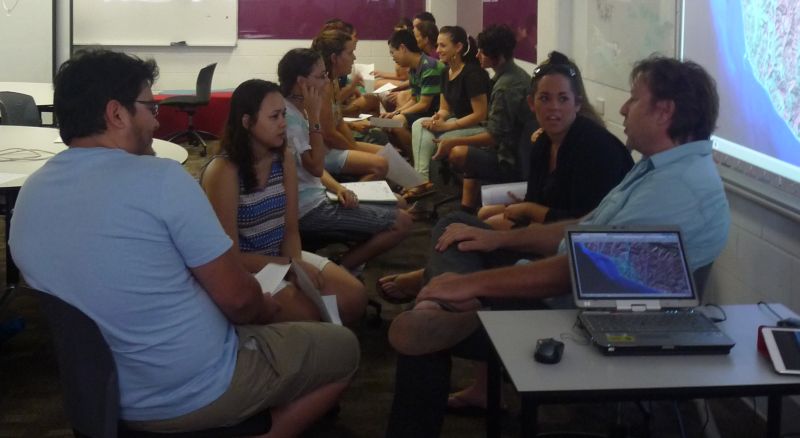
I’m not a huge fan of blogs. To be honest, I never read them. In fact I’m probably close to the blogophobe end of the scale, if there is such a thing. But I do frequently scroll through them. This is because many of the best recipes I have found are hidden at the end of someone’s blog. And they generally have fabulous photos so I can see exactly what my food is going to look like.
So I love food, and recipes, and I love writing. Why not write a recipe? Well, I’m fairly certain that any recipe I write would lead to inedible food. But what about a recipe for something that I actually have experience in? And if it’s a recipe, apparently nowadays it needs to be a blog. So I thought that this would be a perfect opportunity to see if I can become more blogophilic.
Here’s my little bloggy recipe for a flipped classroom. Flipping is a technique where we get students to complete some preparatory theory work at home before coming to class. This is the sort of stuff that’s usually delivered in a lecture, and can be kind of non-exciting. They also have to answer some 'pre-class questions' to keep them on track and accountable.
The ‘lecture’ then turns into a range of interactive exercises for the students. It’s a fun way to teach and really gets the students to engage. There is a bunch of learning benefits also, but that’s for another day.
One of the best things about flipping is that you can ditch the 1,000 slide powerpoint lecture in favour of small ‘snippets’.
If you’re not into lots of chatter and high levels of noise in your class, then this technique is not for you. Maybe you should be a librarian :) I loved having all the students talking and being active participants. They enjoyed it too.
So I love food, and recipes, and I love writing. Why not write a recipe? Well, I’m fairly certain that any recipe I write would lead to inedible food. But what about a recipe for something that I actually have experience in? And if it’s a recipe, apparently nowadays it needs to be a blog. So I thought that this would be a perfect opportunity to see if I can become more blogophilic.
Here’s my little bloggy recipe for a flipped classroom. Flipping is a technique where we get students to complete some preparatory theory work at home before coming to class. This is the sort of stuff that’s usually delivered in a lecture, and can be kind of non-exciting. They also have to answer some 'pre-class questions' to keep them on track and accountable.
The ‘lecture’ then turns into a range of interactive exercises for the students. It’s a fun way to teach and really gets the students to engage. There is a bunch of learning benefits also, but that’s for another day.
One of the best things about flipping is that you can ditch the 1,000 slide powerpoint lecture in favour of small ‘snippets’.
If you’re not into lots of chatter and high levels of noise in your class, then this technique is not for you. Maybe you should be a librarian :) I loved having all the students talking and being active participants. They enjoyed it too.
Prep time: More than you are ever allocated
Class time: 1-2 hrs
Total time: 1-2 hrs ++
Serves: 1 flipped class
Difficulty: Medium
Ingredients:
• 1 traditional powerpoint (or similar) lecture
• Willingness to experiment
• Access to technology (optional, and preferable)
Instructions:
Mise en place
1. Turn off email and set phone off the hook
2. Be prepared to sacrifice the volume of unit content for depth of understanding
3. Review all lecture slides and determine what your students need to be capable of DOING once they leave class
4. Determine the theoretical knowledge they need to have before trying to do (3). This is the stuff that requires less understanding and may simply need to be rote learned to provide a foundation
5. Remove (4) from your lecture and find a relevant reading, video, or activity for the students to do before coming to class – this is your ‘pre-class activity’
6. Devise a method of accountability for the pre-class activity, e.g. filling in answers in a google-docs survey
7. Create an activity / activities to address (3) – this is your ‘in-class activity’. Test and adjust the timings required to complete
8. Create a list for students to highlight what they need to know vs. what they need to do
9. Delete irrelevant powerpoint slides. Note that I like to keep some or create some new ones to help explain the activity
10. Develop your class choreography, including listing of materials required
11. Release your pre-class activity to your class with adequate time for completion
Service
1. Arrive ten minutes before class
2. Check submissions for the pre-class activity to note any areas of mis-understanding to address at the beginning of class
3. Arrange class materials as required
4. Greet students as they arrive
5. Work through your choregraphy using interaction to ‘connect, correct, commend’ your students
6. Note any timing or activity changes required for next time around
Class time: 1-2 hrs
Total time: 1-2 hrs ++
Serves: 1 flipped class
Difficulty: Medium
Ingredients:
• 1 traditional powerpoint (or similar) lecture
• Willingness to experiment
• Access to technology (optional, and preferable)
Instructions:
Mise en place
1. Turn off email and set phone off the hook
2. Be prepared to sacrifice the volume of unit content for depth of understanding
3. Review all lecture slides and determine what your students need to be capable of DOING once they leave class
4. Determine the theoretical knowledge they need to have before trying to do (3). This is the stuff that requires less understanding and may simply need to be rote learned to provide a foundation
5. Remove (4) from your lecture and find a relevant reading, video, or activity for the students to do before coming to class – this is your ‘pre-class activity’
6. Devise a method of accountability for the pre-class activity, e.g. filling in answers in a google-docs survey
7. Create an activity / activities to address (3) – this is your ‘in-class activity’. Test and adjust the timings required to complete
8. Create a list for students to highlight what they need to know vs. what they need to do
9. Delete irrelevant powerpoint slides. Note that I like to keep some or create some new ones to help explain the activity
10. Develop your class choreography, including listing of materials required
11. Release your pre-class activity to your class with adequate time for completion
Service
1. Arrive ten minutes before class
2. Check submissions for the pre-class activity to note any areas of mis-understanding to address at the beginning of class
3. Arrange class materials as required
4. Greet students as they arrive
5. Work through your choregraphy using interaction to ‘connect, correct, commend’ your students
6. Note any timing or activity changes required for next time around

 RSS Feed
RSS Feed
